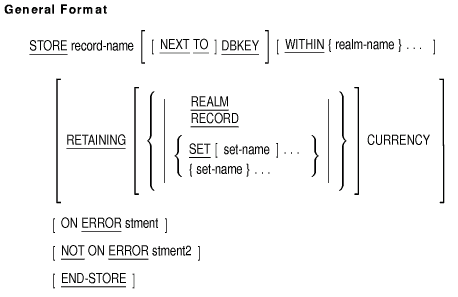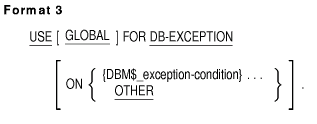 |
HP COBOL
DBMS Database Programming Manual
STORE
Function
The STORE statement stores a new record in the database, establishes
the record as an owner of an empty set of each set type for which the
record is an owner record type, and connects the record as a member to
the current set of each set type for which the record is an AUTOMATIC
member record type.

record-name
names a subschema record type.
realm-name
names a subschema realm.
set-name
names a subschema set type.
stment
is an imperative statement executed for an on error condition.
stment2
is an imperative statement executed for a not on error condition.
Syntax Rules
- Realm-name cannot be specified more than once in the same
STORE statement.
- Set-name cannot be specified more than once in the same
STORE statement.
General Rules
- The STORE statement references the record-name in the user
work area. You must move the data to be in record-name to the
user work area before executing a STORE statement.
- If you specify the WITHIN option, the Database Control System
(DBCS) stores a new record occurrence in one of the realms from the
list of realm-names.
If you do not specify the WITHIN
option, the DBCS stores a new record occurrence in one valid subschema
realm for that record type.
- If you specify the DBKEY option, the target area is determined by
page size. If the page specified by the DB-KEY special register has
space available, that page is the target area. Otherwise, the DBCS
chooses the next page that has available space.
- After a successful STORE operation, the DB-KEY special register
contains the database key for the record.
- The STORE statement stores a record occurrence of the
record-name record type from your user work area to a single
target area.
- If the DBCS can store record-name in more than one realm
or area, the selected realm or area is unspecified.
- The successful STORE statement directs the DBCS to store these
items in the target area:
- Each record-name data item defined in the subschema.
- The default value for any record-name data items defined
in the schema but not defined (omitted) in the subschema. The schema
DEFAULT clause defines the values for these omitted data items.
- The DBCS establishes the newly stored record as the owner record of
an empty set for each set type for which record-name is
defined as the owner record type.
- The DBCS connects the newly stored record as a member record of the
current set of each set type for which record-name is defined
as an AUTOMATIC member record type. The set criteria defined in the
schema for that set type determine the position where the DBCS inserts
record-name.
- Unless otherwise specified by the RETAINING clause (see
Section 4.9.1, RETAINING Clause), these currency indicators point to the stored record:
- Run unit
- Realm
- Record type
- Set type for each set type the record owns, and for each set type
of which it is an AUTOMATIC member
- The contents of the user work area do not change after the
successful or unsuccessful execution of a STORE statement.
- If a database exception condition occurs during the processing of a
STORE statement, the DBCS places a database exception condition code in
the special register DB-CONDITION (see Technical Notes). This code
identifies the condition.
Technical Notes
STORE statement execution can result in these DB-CONDITION database
exception condition codes:
|
DBM$_NODEFVAL
|
There is no schema DEFAULT clause for an omitted data item in
record-name.
|
|
DBM$_CHKITEM
|
A
record-name item contains an invalid value as determined by a
schema CHECK clause.
|
|
DBM$_CHKMEMBER
|
A
record-name item contains an invalid value as determined by a
schema CHECK clause.
|
|
DBM$_CHKRECORD
|
A
record-name item contains an invalid value as determined by a
schema CHECK clause.
|
|
DBM$_CSTYP_NULL
|
The set currency indicator for an AUTOMATIC, nonsingular set type in
which
record-name is a member is null.
|
|
DBM$_CONVERR
|
A data conversion error occurred in the STORE operation.
|
|
DBM$_ILLNCHAR
|
Invalid character found in a numeric field.
|
|
DBM$_NONDIGIT
|
Nonnumeric character found in a numeric field.
|
|
DBM$_OVERFLOW
|
A data overflow error occurred in the STORE operation.
|
|
DBM$_TRUNCATION
|
A data truncation error occurred in the STORE operation.
|
|
DBM$_UNDERFLOW
|
A data underflow error occurred in the STORE operation.
|
|
DBM$_SETSELECT
|
You cannot store this record using this subschema. Either add the
specified set type to your subschema or use a different subschema.
|
Additional References
- Section 2.2, on reserved words (database special registers)
- HP COBOL Reference Manual, Chapter 6, section on scope of statements
- Section 4.8.1, on database On Error condition
- Section 5.14.1, on RETAINING clause
- USE statement
Example
010-ADD-NEW-CLASS-RECORDS.
DISPLAY "ENTER CLASS CODE".
ACCEPT CLASS_CODE.
DISPLAY "ENTER CLASS DESCRIPTION".
ACCEPT CLASS_DESC.
DISPLAY "ENTER CLASS STATUS".
ACCEPT CLASS_STATUS.
STORE CLASS_REC WITHIN MAKE
ON ERROR DISPLAY "ERROR STORING CLASS..."
PERFORM 200-STORE-CLASS-ERROR
END-STORE.
|
USE
Function
The USE statement specifies Declaratives procedures to handle file
input/output errors and database exception conditions. It can also
specify procedures to be executed before the program processes a
specific report group.
These procedures supplement the procedures in the COBOL Run-Time System
and RMS.
USE
is part of the COBOL ANSI standard.
Formats 1 and 2
Refer to the HP COBOL Reference Manual for Formats 1 and 2. Only Format 3 is
applicable to DBMS DML.

DBM$_exception-condition
is a symbolic constant name beginning with the characters DBM$_. It
identifies an Oracle CODASYL DBMS exception condition. Refer to the
Oracle CODASYL DBMS documentation set for information on DML error and
warning messages.
Syntax Rules
All Formats
- A USE statement can be used only in a sentence immediately after a
section header in the Procedure Division Declaratives area. It must be
the only statement in the sentence. The rest of the section can contain
zero, one, or more paragraphs to define the particular USE procedures.
- The USE statement itself does not execute. It defines the
conditions that cause execution of the associated USE procedure.
- Refer to HP COBOL Reference Manual for information on USE formats 1 and 2.
Format 3
- The DBM$_exception-condition argument must begin with
these five characters: DBM$_.
- If the phrase USE [GLOBAL] FOR DB-EXCEPTION. occurs, it is the only
USE procedure allowed in the program.
- Multiple occurrences of the USE statement can exist within a
program only if the ON phrase is specified.
DBM$_exception-condition in each USE statement must be unique.
Multiple USE statements must not cause the simultaneous request for
execution of more than one USE procedure. The OTHER phrase may be
specified only once in a program.
- If a USE FOR DB-EXCEPTION statement does not specify the ON phrase,
it must be the only occurrence of Format 3 of the USE statement in the
program.
General Rules
All Formats
- At run time, two special precedence rules apply for the selection
of a USE procedure when a program is contained within another program.
In applying these rules, only the first qualifying USE procedure is
selected for execution. The order of precedence for the selection of a
USE procedure is as follows:
- First, select the USE procedure within the program containing the
statement that caused the qualifying condition.
- If a USE procedure is not found in the program using the previous
rule, the Run-Time System searches all programs directly or indirectly
containing that program for a USE GLOBAL... Declaratives procedure.
This search continues until the Run-Time System either: (a) finds an
applicable USE GLOBAL Declaratives procedure, or (b) finds the
outermost containing program, if there is no applicable USE GLOBAL
Declaratives. Either condition terminates the search.
- A USE procedure cannot refer to a non-Declaratives procedure.
However, only the PERFORM statement can transfer execution control from:
- A Declaratives procedure to another Declaratives procedure
- A non-Declaratives procedure to a Declaratives procedure
- After a USE procedure executes, control returns to the next
executable statement in the invoking routine, if one is defined.
Otherwise, control transfers according to the rules for Explicit and
Implicit Transfers of Control.
- A program must not execute a statement in a USE procedure that
would cause execution of a USE procedure that had been previously
executed and had not yet returned control to the routine that invoked
it.
|

